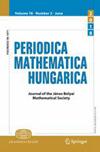沃尔什-傅里叶级数的矩阵变换手段子序列的规范收敛性
IF 0.5
3区 数学
Q3 MATHEMATICS
引用次数: 0
摘要
让 \(\{a_{n}:\ n\in \mathbb {P}\}) 是一个正整数递增序列。对于每一个(n\in \mathbb {P}),让({t_{k,a_{n}}: 1\le k\le a_{n},\ k\in \mathbb {P})是一个非负数的有限序列,使得$$(begin{aligned})。\sum_{k=1}^{a_{n}}t_{k,a_{n}}=1(end{aligned})$$holds 和 $$\begin{aligned}\我們的主要結果(定理 6.5)是我們證明 (L_{1}\)-規範收斂 $$begin{aligned}。\例如,但不限于 (a_{n}:=2^{n}\),见推论 6.6 和第 7 节),其条件比之前已知的矩阵变换手段和一些特殊手段(即诺尔隆德手段和加权手段)要弱。本文章由计算机程序翻译,如有差异,请以英文原文为准。
Norm convergence of subsequences of matrix transform means of Walsh–Fourier series
Let \(\{a_{n}:\ n\in \mathbb {P}\}\) be an increasing sequence of positive integers. For every \(n\in \mathbb {P}\) let \(\{t_{k,a_{n}}: 1\le k\le a_{n},\ k\in \mathbb {P}\}\) be a finite sequence of non-negative numbers such that
$$\begin{aligned} \sum _{k=1}^{a_{n}} t_{k,a_{n}}=1 \end{aligned}$$holds and
$$\begin{aligned} \lim _{n\rightarrow \infty }t_{k,a_{n}}=0 \end{aligned}$$is satisfied for any fixed k. Our main result (Theorem 6.5) is that we prove \(L_{1}\)-norm convergence
$$\begin{aligned} \sigma _{a_{n}}^{T}(f)\rightarrow f \end{aligned}$$(for example, but not limited to \(a_{n}:=2^{n}\), see Corollary 6.6 and Sect. 7) with weaker conditions than it was known before for matrix transform means and for some special means, namely Nörlund and weighted ones.
求助全文
通过发布文献求助,成功后即可免费获取论文全文。
去求助
来源期刊
CiteScore
1.40
自引率
0.00%
发文量
67
审稿时长
>12 weeks
期刊介绍:
Periodica Mathematica Hungarica is devoted to publishing research articles in all areas of pure and applied mathematics as well as theoretical computer science. To be published in the Periodica, a paper must be correct, new, and significant. Very strong submissions (upon the consent of the author) will be redirected to Acta Mathematica Hungarica.
Periodica Mathematica Hungarica is the journal of the Hungarian Mathematical Society (János Bolyai Mathematical Society). The main profile of the journal is in pure mathematics, being open to applied mathematical papers with significant mathematical content.

 求助内容:
求助内容: 应助结果提醒方式:
应助结果提醒方式:


